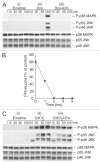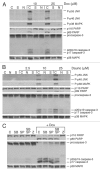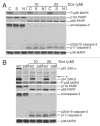ZAK is required for doxorubicin, a novel ribotoxic stressor, to induce SAPK activation and apoptosis in HaCaT cells
- PMID: 20559024
- PMCID: PMC3040836
- DOI: 10.4161/cbt.10.3.12367
ZAK is required for doxorubicin, a novel ribotoxic stressor, to induce SAPK activation and apoptosis in HaCaT cells
Abstract
Doxorubicin is an anthracycline drug that is one of the most effective and widely used anticancer agents for the treatment of both hematologic and solid tumors. The stress-activated protein kinases (SAPKs) are frequently activated by a number of cancer chemotherapeutics. When phosphorylated, the SAPKs initiate a cascade that leads to the production of proinflammatory cytokines. Some inhibitors of protein synthesis, known as ribotoxic stressors, coordinately activate SAPKs and lead to apoptotic cell death. We demonstrate that doxorubicin effectively inhibits protein synthesis, activates SAPKs, and causes apoptosis. Ribotoxic stressors share a common mechanism in that they require ZAK, an upstream MAP3K, to activate the pro-apoptotic and proinflammatory signaling pathways that lie downstream of SAPKs. By employing siRNA mediated knockdown of ZAK or administration of sorafenib and nilotinib, kinase inhibitors that have a high affinity for ZAK, we provide evidence that ZAK is required for doxorubicin-induced proinflammatory and apoptotic responses in HaCaT cells, a pseudo-normal keratinocyte cell line, but not in HeLa cells, a cancerous cell line. ZAK has two different isoforms, ZAK-α (91 kDa) and ZAK-β (51 kDa). HaCaT or HeLa cells treated with doxorubicin and immunoblotted for ZAK displayed a progressive decrease in the ZAK-α band and the appearance of ZAK-β bands of larger size. Abrogation of these changes after exposure of cells to sorafenib and nilotinib suggests that these alterations occur following stimulation of ZAK. We suggest that ZAK inhibitors such as sorafenib or nilotinib may be effective when combined with doxorubicin to treat cancer patients.
Figures





References
-
- Takemura G, Fujiwara H. Doxorubicin-induced cardiomyopathy from the cardiotoxic mechanisms to management. Prog Cardiovasc Dis. 2007;49:330–352. - PubMed
-
- Gewirtz DA. A critical evaluation of the mechanisms of action proposed for the antitumor effects of the anthracycline antibiotics adriamycin and daunorubicin. Biochem Pharmacol. 1999;57:727–741. - PubMed
-
- Singal PK, Li T, Kumar D, Danelisen I, Iliskovic N. Adriamycin-induced heart failure: mechanism and modulation. Mol Cell Biochem. 2000;207:77–86. - PubMed
-
- Wood LJ, Nail LM, Gilster A, Winters KA, Elsea CR. Cancer chemotherapy-related symptoms: evidence to suggest a role for proinflammatory cytokines. Oncol Nurs Forum. 2006;33:535–542. - PubMed
-
- Kalyanaraman B, Joseph J, Kalivendi S, Wang S, Konorev E, Kotamraju S. Doxorubicin-induced apoptosis: implications in cardiotoxicity. Mol Cell Biochem. 2002;234:119–124. - PubMed
Publication types
MeSH terms
Substances
Grants and funding
LinkOut - more resources
Full Text Sources
Molecular Biology Databases
